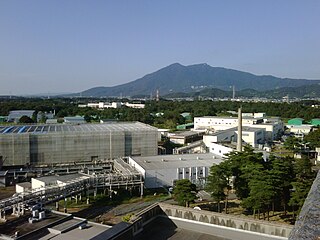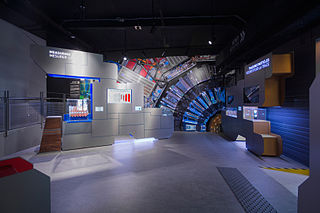
The European Organization for Nuclear Research, known as CERN, is a European research organization that operates the largest particle physics laboratory in the world. Established in 1954, the organization is based in a northwest suburb of Geneva on the Franco–Swiss border and has 23 member states. Israel is the only non-European country granted full membership. CERN is an official United Nations Observer.

Fermi National Accelerator Laboratory (Fermilab), located just outside Batavia, Illinois, near Chicago, is a United States Department of Energy national laboratory specializing in high-energy particle physics. Since 2007, Fermilab has been operated by the Fermi Research Alliance, a joint venture of the University of Chicago, and the Universities Research Association (URA). Fermilab is a part of the Illinois Technology and Research Corridor.

The Tevatron was a circular particle accelerator in the United States, at the Fermi National Accelerator Laboratory, east of Batavia, Illinois, and is the second highest energy particle collider ever built, after the Large Hadron Collider (LHC) of the European Organization for Nuclear Research (CERN) near Geneva, Switzerland. The Tevatron was a synchrotron that accelerated protons and antiprotons in a 6.28 km (3.90 mi) ring to energies of up to 1 TeV, hence its name. The Tevatron was completed in 1983 at a cost of $120 million and significant upgrade investments were made during its active years of 1983–2011.

A linear particle accelerator is a type of particle accelerator that accelerates charged subatomic particles or ions to a high speed by subjecting them to a series of oscillating electric potentials along a linear beamline. The principles for such machines were proposed by Gustav Ising in 1924, while the first machine that worked was constructed by Rolf Widerøe in 1928 at the RWTH Aachen University. Linacs have many applications: they generate X-rays and high energy electrons for medicinal purposes in radiation therapy, serve as particle injectors for higher-energy accelerators, and are used directly to achieve the highest kinetic energy for light particles for particle physics.

The Large Hadron Collider (LHC) is the world's largest and highest-energy particle collider and the largest machine in the world. It was built by the European Organization for Nuclear Research (CERN) between 1998 and 2008 in collaboration with over 10,000 scientists and hundreds of universities and laboratories, as well as more than 100 countries. It lies in a tunnel 27 kilometres (17 mi) in circumference and as deep as 175 metres (574 ft) beneath the France–Switzerland border near Geneva.

A synchrotron is a particular type of cyclic particle accelerator, descended from the cyclotron, in which the accelerating particle beam travels around a fixed closed-loop path. The magnetic field which bends the particle beam into its closed path increases with time during the accelerating process, being synchronized to the increasing kinetic energy of the particles. The synchrotron is one of the first accelerator concepts to enable the construction of large-scale facilities, since bending, beam focusing and acceleration can be separated into different components. The most powerful modern particle accelerators use versions of the synchrotron design. The largest synchrotron-type accelerator, also the largest particle accelerator in the world, is the 27-kilometre-circumference (17 mi) Large Hadron Collider (LHC) near Geneva, Switzerland, built in 2008 by the European Organization for Nuclear Research (CERN). It can accelerate beams of protons to an energy of 6.5 teraelectronvolts (TeV).

The Compact Linear Collider (CLIC) is a concept for a future linear particle accelerator that aims to explore the next energy frontier. CLIC would collide electrons with positrons and is currently the only mature option for a multi-TeV linear collider. The accelerator would be between 11 and 50 km long, more than ten times longer than the existing Stanford Linear Accelerator (SLAC) in California, USA. CLIC is proposed to be built at CERN, across the border between France and Switzerland near Geneva, with first beams starting by the time the Large Hadron Collider (LHC) has finished operations around 2035.

The International Linear Collider (ILC) is a proposed linear particle accelerator. It is planned to have a collision energy of 500 GeV initially, with the possibility for a later upgrade to 1000 GeV. Although early proposed locations for the ILC were Japan, Europe (CERN) and the USA (Fermilab), the Kitakami highland in the Iwate prefecture of northern Japan has been the focus of ILC design efforts since 2013. The Japanese government is willing to contribute half of the costs, according to the coordinator of study for detectors at the ILC.

The High Energy Accelerator Research Organization, known as KEK, is a Japanese organization whose purpose is to operate the largest particle physics laboratory in Japan, situated in Tsukuba, Ibaraki prefecture. It was established in 1997. The term "KEK" is also used to refer to the laboratory itself, which employs approximately 695 employees. KEK's main function is to provide the particle accelerators and other infrastructure needed for high-energy physics, material science, structural biology, radiation science, computing science, nuclear transmutation and so on. Numerous experiments have been constructed at KEK by the internal and international collaborations that have made use of them. Makoto Kobayashi, emeritus professor at KEK, is known globally for his work on CP-violation, and was awarded the 2008 Nobel Prize in Physics.

The Super Proton Synchrotron (SPS) is a particle accelerator of the synchrotron type at CERN. It is housed in a circular tunnel, 6.9 kilometres (4.3 mi) in circumference, straddling the border of France and Switzerland near Geneva, Switzerland.

Microcosm or CERN Museum is an interactive exhibition presenting the work of the CERN particle physics laboratory and its flagship accelerator the Large Hadron Collider (LHC). The current exhibition officially opened in January 2016. Contents were developed by CERN in collaboration with Spanish design team Indissoluble.

ALICE is one of eight detector experiments at the Large Hadron Collider at CERN. The other seven are: ATLAS, CMS, TOTEM, LHCb, LHCf, MoEDAL and FASER.
The High Luminosity Large Hadron Collider (HL-LHC; formerly SLHC, Super Large Hadron Collider) is an upgrade to the Large Hadron Collider started in June 2018 that will boost the accelerator's potential for new discoveries in physics, starting in 2027. The upgrade aims at increasing the luminosity of the machine by a factor of 10, up to 1035 cm−2s−1, providing a better chance to see rare processes and improving statistically marginal measurements.

A particle accelerator is a machine that uses electromagnetic fields to propel charged particles to very high speeds and energies, and to contain them in well-defined beams.

The Low Energy Ion Ring (LEIR) is a particle accelerator at CERN used to accelerate ions from the LINAC 3 to the Proton Synchrotron (PS) to provide ions for collisions within the Large Hadron Collider (LHC).

The CERN hadron Linacs are linear accelerators that accelerate beams of hadrons from a standstill to be used by the larger circular accelerators at the facility.
An energy recovery linac (ERL) provides a beam of electrons used to produce x-rays by synchrotron radiation. First proposed in 1965 the idea gained interest since the early 2000s.

The Future Circular Collider (FCC) is a proposed post-LHC particle accelerator with an energy significantly above that of previous circular colliders. After injection at 3.3 TeV, each beam would have a total energy of 560 MJ. With a centre-of-mass collision energy of 100 TeV the total energy value increases to 16.7 GJ. These total energy values exceed the present LHC by nearly a factor of 30.
An electron–ion collider (EIC) is a type of particle accelerator collider designed to collide spin-polarized beams of electrons and ions, in order to study the properties of nuclear matter in detail via deep inelastic scattering. In 2012, a whitepaper was published, proposing the developing and building of an EIC accelerator, and in 2015, the Department of Energy Nuclear Science Advisory Committee (NSAC) named the construction of an electron–ion collider one of the top priorities for the near future in nuclear physics in the United States.

The LEP Pre-Injector (LPI) was the initial source that provided electrons and positrons to CERN's accelerator complex for the Large Electron–Positron Collider (LEP) from 1989 until 2000.















